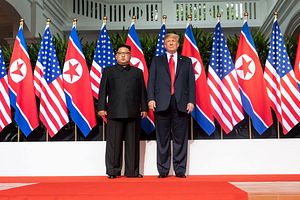The 2019 diplomatic season between the United States and North Korea is officially on. Last Friday, North Korean official Kim Yong-chol – the man who has been the lead negotiator on behalf of Kim Jong-un since the Singapore summit last June – visited Washington.
He became the first North Korean official since Jo Myong-rok, Kim Jong-il’s envoy in 2000, to spend a night in the U.S. capital. He briefly met his counterpart, U.S. Secretary of State Mike Pompeo, then spent nearly two hours in the Oval Office with President Donald Trump.
Since its Singapore talks with Trump, North Korea has made clear its preference to deal directly with the president. Pyongyang has perceived, correctly, that Trump is unlike the presidents that preceded him. He is less attached to old shibboleths about what the United States might or might not accept in a negotiation with North Korea.
The best evidence of this came after his June meetings with Kim Jong-un, when Trump announced, without having consulted South Korea, that the then-forthcoming Ulchi Freedom Guardian military drills would be cancelled.
After the latest meetings in Washington, it is unclear whether either side has changed its basic position. The White House appears to be still committed to the objective of final, fully verified denuclearization of North Korea. And although U.S. officials continue to repeat that this is what Kim Jong-un agreed to in Singapore, nothing could be further from reality.
In Singapore, Kim agreed to “work towards the denuclearization of the Korean peninsula”. In the months since, North Korean officials have been frustrated at the White House’s consistent insistence on the alternative phrasing – a phrasing that implies the unilateral disarmament of North Korea.
For Pyongyang, to denuclearize the Korean peninsula means to remove the United States’ nuclear umbrella from South Korea. It’s unclear whether Kim Yong-chol took the opportunity to explain this to Trump during their latest encounter in Washington.
Regardless of any mutual understanding, the process that is under way is likely to result in a second summit between Trump and Kim Jong-un. The White House has announced that the meeting will probably take place “near the end of February”.
The weeks between now and that summit will be critical. Barring a major breakthrough, the two sides will be doomed to a vague summit declaration like the one we saw in Singapore. Of course, breakthroughs in these sorts of negotiations do not just happen; they have to be created.
One possibility for the creation of such a breakthrough is via a second route. After meeting Kim Yong-chol in Washington, Stephen Biegun, the Trump administration’s Special Representative for North Korea, jetted off to Stockholm, where he is due to meet Choe Son-hui, an experienced North Korea diplomat who has negotiated with Americans for years.
Choe and Biegun are meant to discuss the details: everything from the “corresponding measures” that North Korea has said it is seeking from the United States, to the next possible steps on denuclearization. The Stockholm encounter will offer an opportunity to build towards something new at the second summit.
An area of friction in the lead-up to the summit will be the forthcoming Key Resolve and Foal Eagle joint exercises by the U.S. and South Korea. North Korea complains annually about these drills, claiming they represent little more than a ruse to overrun its territory. The alliance has said the exercises will be calibrated so as not to inhibit diplomacy, but Pyongyang has this month called for their complete cancellation.
The weeks leading up to the second Trump-Kim summit will not be friction-free. Even if that friction can be managed, allowing for another photo opportunity between the two leaders, there is little indication that the U.S. is any closer to its stated goal of verifiably disarming North Korea.
Instead, perhaps the two sides might focus on other objectives, asserted in the Singapore declaration: forging better diplomatic ties between them and working towards a sustainable peace regime in coordination with South Korea.
This article first appeared in the South China Morning Post. It is republished here with kind permission.

































